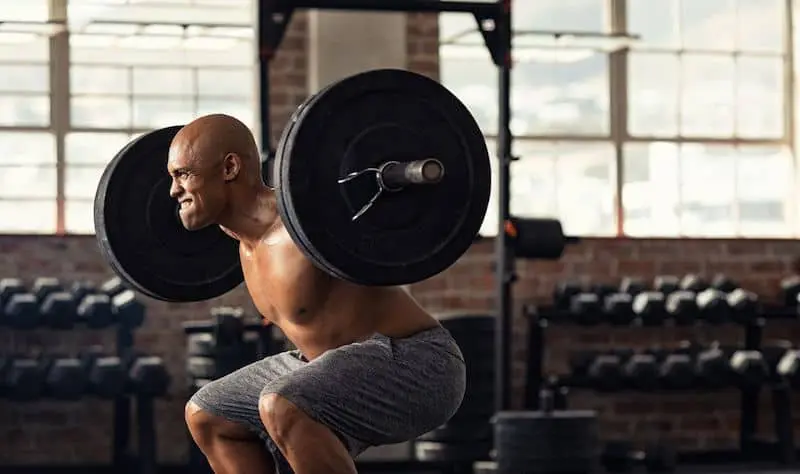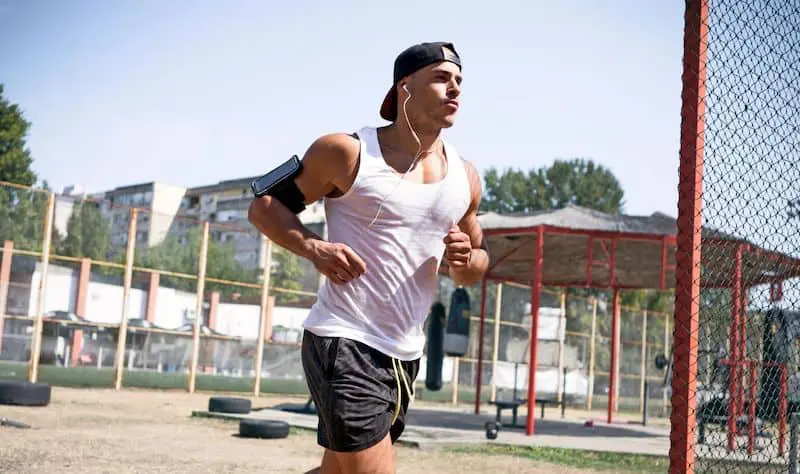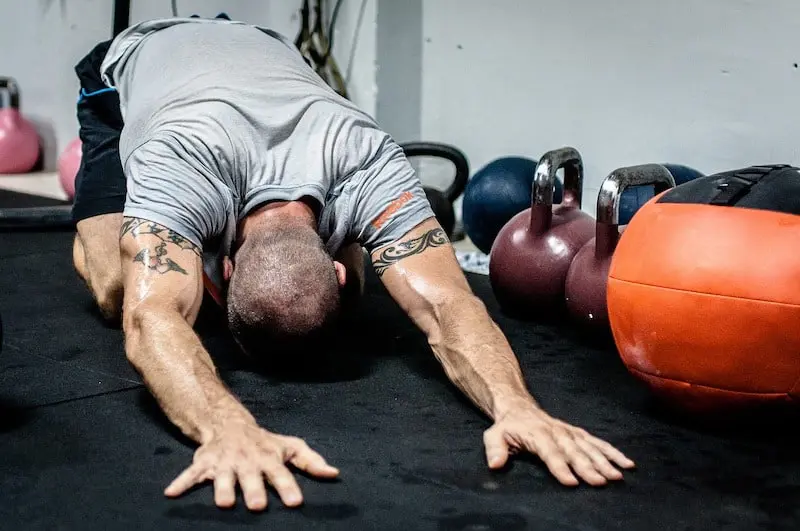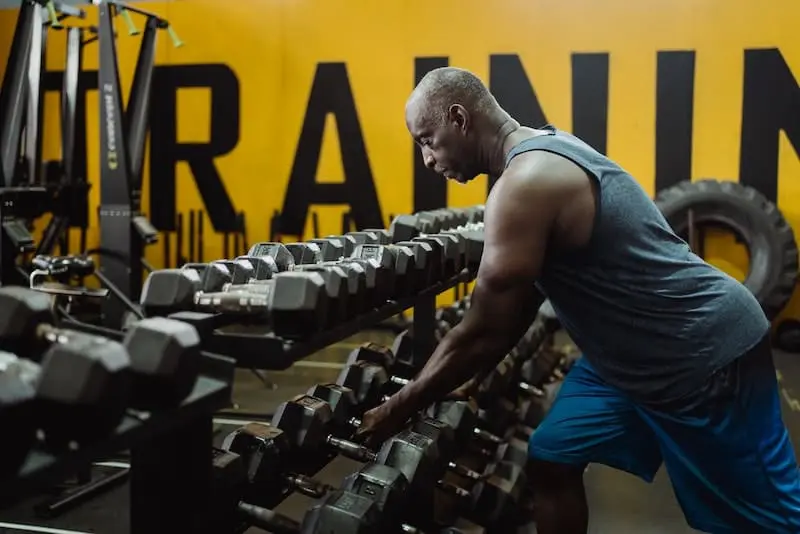
The best online fitness resource you'll ever need. We filter out the BS to ensure you meet your health and fitness goals!

The best online fitness resource you'll ever need. We filter out the BS to ensure you meet your health and fitness goals!

Welcome to the Ultimate 6 Day Push Pull Legs Workout Routine, designed to increase muscle gains and improve overall body composition.
Push pull legs (PPL) splits are a very popular three-way split and are often programmed by the best coaches. They are intended to divide the total body into logical work segments so that each gets resistance training at least once a week.
This workout routine will take you through exactly how to optimally leverage a PPL 6 day split to gain muscle mass and maintain it.
Jump to the workout routine.
Or click on the link below to download a free PDF copy:
| Program style | Resistance training and bodybuilding |
| Program structure | Push Pull Legs |
| Program duration | Forever |
| Workout duration | 1-2 hours |
| Scheduling | 6 day split |
| Goal | Body transformation |
| Level | Beginners to advanced |
Because the way PPL splits arrange exercises, they’re an easy way to implement and as a result, easy to remember which exercises go where.
There’s some nuance, but in general, you don’t have to use a lot of brainpower or do exercise research to do one.
PPLs address all the major skeletal muscles, both functional and visible. Some exercises address deep muscles you can’t see, like the rhomboids.
By its design, the PPL split separates agonist and antagonist muscles to a great degree and by doing that, pays attention to recovery. The same muscles aren’t worked in every workout, other than the forearms, which of course get some load in nearly every workout.
PPLs are also very flexible (you can move exercises around based on where they fit, whether a push, a pull, or leg exercise), and they can be adapted to a variety of life schedules.
PPLs can be organized into as few as three days a week and up to six, which is the one I’ll describe here.
Working more days per week potentially provides more total work. More activity, for sure, which means that you get a daily dose of exercise, except on your rest day of course.
You should know what you’re getting yourself into here, and what you should expect to get out of a PPL 6 day split routine. Here’s the summary:
If you do it right, you can expect to gain muscle and see some positive change in your shape. This will be especially true if you’re relatively new to weight training, as in having lifted weights for less than a decade.
You can expect to be doing a lot of work and also feeling like you’re doing a lot of work. Six days in the gym at even a moderate level of intensity is a lot.
I seldom (as in almost never) program a six-day program for my clients. Still, many who want to build a better body are dissatisfied with a four or even five-day program and believe the sixth is necessary. Some of this is born from brainwashing by the fitness industry that working out non-stop is what leads to better bodies.
One study found that full recovery following high intensity resistance exercise took two days and subjective perception of recovery took up to six.
So expect your recovery needs to increase; if you’re not accustomed to this many days in the gym doing this amount of work. Six days in the gym requires skill and vigilance…you have to know the signs of overtraining.
Expect to require more sleep. You’ll need to be as disciplined about getting enough high-quality sleep as you are at getting into the gym. For this routine, you should aim for eight to 10 hours nightly. You’ll need to sleep like an athlete.
Our Push Pull Legs workout routine breaks down like this in summary:
| Day | Split |
|---|---|
| 1 | Legs |
| 2 | Chest, Shoulders, Triceps |
| 3 | Back, Biceps |
| 4 | Legs |
| 5 | Chest, Shoulders, Triceps |
| 6 | Back, Biceps |
| 7 | REST |
You’ll notice that we start with Legs instead of a “push” day. That’s intentional.
Working out the legs the day after a rest day is generally smart. Leg Day 1 should be the most challenging workout of the week simply due to its demands.

The second leg day of the week is of slightly less intensity. The Push days that follow should allow for adequate recovery of the legs.
The program further segments the Push, Pull, and Leg days into specific exercises, so that you end up with two different Push, Pull, and Leg days each week. So there’s some variety, which most people like.
NOTE: There is significant debate over whether exercise variety matters…it probably doesn’t as long as the ones you do load the muscles in productive ways. Changing exercises to “trick” your muscles isn’t productive. The muscles of the body work the same way all the time and are not subject to being fooled simply by moving in a different way.
A couple of additional (but important) notes:

You’ll notice no cardio in this routine. That is intentional.
I don’t discourage cardio for my own clients who weight train. There’s value in doing some cardio. You just have to pay attention to recovery which is where your gains actually happen.
For cardio-respiratory work, I prefer LISS, Low Intensity Steady State exercise. I personally like long walks, and I’ve read other pros in the space who share that preference.
For me (and anecdotally for those who agree), low intensity aerobic exercise leaves room for muscular and neuromuscular recovery in the presence of a rigorous resistance exercise program like the one described here.
I’m also a fan of walking backward on a treadmill for knee health, as described by the Knees Over Toes Guy, Ben Patrick. He recommends doing this with the treadmill turned off for greater resistance. For our purposes here, it’s fine to turn on the treadmill motor; just add the intensity if you need to.
The heatedness of the debate around cardio for fat loss is–thank heaven–subsiding as more fitness practitioners see best physique results coming from intelligent nutrition programming and resistance exercise.
Observation alone has thrown the much-deserved shade on cardio for leanness. Just looking around the gym at the people who only do cardio and seeing that their physiques never change for the better is leading people to shun the treadmills and bikes in favor of the weights.
Do cardio to improve breathing. If you can’t breathe, you can’t lift, and building muscle through resistance training is what changes body composition when combined with proper nutrition in the right amounts.
If you want to lose fat, reduce your food intake and increase its quality. Start by eliminating the easily digestible processed foods and reduce portion size. Think:
This routine requires a commercial gym or a well-equipped home gym. Here’s the rundown.
| Exercise | Equipment Options |
|---|---|
| Unloaded squats | TRX or bands |
| Sissy Squats | Bodyweight (add BB plate or weighted vest if needed), cable machine, or Pendulum Squat machine (if available) |
| HTC Split Squats | Dumbbells |
| Leg Extensions | Leg Extension machine |
| Leg Curls | Leg Curl machine, seated or prone |
| Hip Extensions | Cable or Multi-Hip machine |
| Toe raises | Bodyweight or Tib Anterior accessory |
| Warm-up with unloaded squats | TRX or bands |
| Squats, heel elevated | Dumbbells or Barbell |
| Romanian Deadlift (RDL) | Dumbbells or Trap Bar |
| Hip Abductions | Cable or Multi-Hip machine |
| Hip Adductions | Cable or Adduction machine |
| Hip Flexions | Cable machine |
| Standing Calf raises | Dumbbells, Calf machine |
| Stair climbing or Walking | Stair machine or treadmill if in-gym |
| Biceps Curls, single arm | Cables, or Dumbbells |
| Gironda Drag Curls | BB |
| Triceps extensions | Cable machine, any attachment (straight, EZ Curl, V-bar) |
| Hammer Curls | Dumbbells |
| Side Lateral Raises | Cable machine, Dumbbells |
| Rear Delt Flyes | Cable machine, Dumbbells |
| Shrugs | Cable machine, DB, BB, shrug machine |
| Hammer Grip Shoulder Press | Dumbbells |
| Incline DB Rows or Helms Row | Dumbbells |
| Infraspinatus raises | Dumbbells |
| “Y” Raises (Plate Raises) | Dumbbells or Barbell plate |
| Decline DB Presses or Cable Chest Presses | Dumbbells or Dual Axis Cable machine |
| Flat DB Bench | Dumbbells or Dual Axis Cable machine |
| Pec Deck | Forearm pad version preferred. |
| Underhand Chest Press | Dumbbells or Cable machine |
| Dumbbell Presses, overhand flat bench | Dumbbells |
| Lat Pull-Ins | Cable machine |
| Chest-supported DB row | Dumbbells |
| Scapula Shrugs | Cable machine, or Dumbbells and incline bench |
| Back Extensions | Roman chair, Barbell plate optional |
| Lat Pull-Downs | Cable machine, wider-than-shoulder width handle |
| Motorcycle Rows | Cable machine |
| Crunches | Bench or Floor |
| Sit Ups with a Twist | Bench or Floor |
| Side Bends | Cable machine or Dumbbells |
| Stairs | Stair machine, or staircase. RPE 5-6 |
| Walk | Path with hills if available, or treadmill set on incline. RPE 5-6 |
Let’s break out the workout days according to split, describe what’s involved in each one, and give you an idea of what to expect each day.
| Exercise | Target Muscles | Reps | Sets |
|---|---|---|---|
| Pendulum Machine or Sissy Squats | Quadriceps | 8-12 | 4 |
| Heel-To-Calf Split Squats | Quadriceps | 8-12 | 4 |
| Leg Extensions | Quadriceps | 10-20 | 3 |
| Romanian Deadlift (RDL) | Glutes, Adductors, Hamstrings, Spinus erectors | 8-12 | 3 |
| Leg Curls | Hamstrings | 8-12 | 3 |
| Toe raises | Tibialis anterior | 20-30 | 2 |
| Exercise | Target Muscles | Reps | Sets |
|---|---|---|---|
| Decline DB Presses or Cable Chest Presses | Pec major | 8-20 | 4 |
| Dumbbell Presses, overhand flat bench | Pec major, Anterior deltoid | 8-20 | 4 |
| Pec Deck | Pec major | 8-20 | 4 |
| Side Lateral Raises | Middle deltoids | 10-20 | 4 |
| Rear Delt Cable or DB Flyes | Posterior deltoids | 10-20 | 4 |
| Triceps extensions | Triceps | 8-15 | 4 |
| Exercise | Target Muscles | Reps | Sets |
|---|---|---|---|
| Lat Pull-Ins | Latissimus dorsi (lats) | 10-20 | 4 |
| Chest-supported DB row | Lats, Posterior deltoids, Middle and Lower Trapezius | 10-20 | 3 |
| Back Extensions | Spinus erectors | 12-20 | 2 |
| Biceps Curls, single arm | Biceps | 12-20 | 3 |
| Gironda Drag Curls | Biceps | 10-15 | 3 |
| Crunches | Rectus abdominis | 20 | 3 |
| Sit Ups with a Twist | Obliques, rectus abdominis | 10 per side | 3 |
| Side Bends | Obliques | 10 per side | 3 |
We devote the second leg day of the week to compound exercises for the upper leg and for the glutes.
| Exercise | Target Muscles | Reps | Sets |
|---|---|---|---|
| Squats, heel elevated | Quadriceps, Glutes, Adductors, Spinus erectors | 12-20 | 3 |
| Walking Lunges | Quadriceps, Glutes, Adductors | 16-30 | 3 |
| Hip Extensions | Glutes | 12-20 | 3 |
| Hip Abductions | Gluteus medius | 12-20 | 3 |
| Hip Adductions | Leg Adductors | 12-20 | 3 |
| Hip Flexions (Knee raises) | Rectus Femoris | 12-20 | 3 |
| Standing Calf raises | Gastrocnemius, Soleus | 15-20 | 3 |
| Exercise | Target Muscles | Reps | Sets |
|---|---|---|---|
| Underhand Chest Press | Clavicular head of pec major, anterior deltoid | 10-20 | 4 |
| Single or Two-arm High-to-Low Cable Fly | Costal region of pec major | 10-20 | 4 |
| Thumbs Up Front Raises, Cable or DB | Anterior deltoid, Clavicular head of pec major | 10-20 | 3 |
| Hammer Grip Shoulder Press | Anterior deltoids primarily, middle delt secondarily | 10-12 | 3 |
| Triceps extensions | Triceps | 8-15 | 4 |
| Exercise | Target Muscles | Reps | Sets |
|---|---|---|---|
| Lat Pull-Downs | Lats, Lower and middle trapezius, teres major, biceps | 10-20 | 4 |
| Motorcycle Rows | Lats, Lower and middle trapezius, teres major, biceps | 10-20 | 4 |
| Chest Supported DB rows | Posterior deltoid | 10-20 | 3 |
| Shrugs | Upper Trapezius | 10-15 | 4 |
| Scapula Shrugs | Middle and Lower trapezius | 10-20 | 3 |
| DB “Y” Raises (or Plate Raises) | Upper Trapezius primarily, middle and lower traps secondarily | 10-15 | 3 |
| Hammer Curls | Brachio-radialis | 10-20 | 4 |
| Crunches | Rectus abdominis | 20 | 3 |
| Sit Ups with a Twist | Obliques, rectus abdominis | 10 per side | 3 |
| Side Bends | Obliques | 10 per side | 3 |

Warm up before your workout to prevent injury and practice the movements. Warm-ups are important for anyone and even more crucial for older adults. If you’re a newcomer to the gym but a veteran in another sport, you’ll already understand the value of a good warm-up.
The warm-ups included in this PPL 6 day split are composed of very light sets of the movements you’ll be doing during the workout, an application of the SAID Principle (Specific Adaptation to Imposed Demands).
You should also get in the habit of stretching the target muscles before actually targeting them. This program will target basically every single muscle you have in your body, so getting those muscle loose is crucial.
There’s nothing worse than getting started on a heavy set of bench press and pulling a pectoral muscle, which could have easily been prevented with some simple chest stretches.

Progressive overload is one of the two ways you’ll track your progress (the other being the mirror).
Progressive overload is a simple concept although surprisingly few practice it well.
There is no requirement for setting a baseline by doing a 1-rep-max. Take the opposite approach. Start with lighter weight and add resistance to find the sweet spot to begin, and then grow from there.
Here’s a simple example of applying progressive overload:
If your rep range is 8 to 12 and your form isn’t perfect at rep #8, lower the weight…the weight is too heavy. If the weight you choose lets you cruise through the set to reps 13, 14, and 15, the weight is too light. Raise it until you cannot do another rep between 8 and 12 with good form.
Finally…
Master the exercises at the specified rep ranges before increasing the weight.

Your muscles are going to get the most benefit from those final few challenging reps. That’s when your brain is recruiting more muscle fibers for the task at hand i.e., lifting the weight. If you cruise through a set effortlessly and end it too soon with additional RIR, don’t expect to be looking at your new jacked physique in the mirror anytime soon.
High intensity should never be an excuse using bad form, nor does it mean a certain rep speed. That said, when intensity and progressive overload are where they should be, the weight won’t be moving fast during those final reps even though you’ll be pushing (or pulling) like hell.
Rep cadence should be rhythmic pumping until those last few tough reps. Do not add velocity or cheat reps. If you’re unable to do a rep with perfect form, select lighter weight or do fewer reps within the specified rep range. See Progressive Overload above.

Recovery is the period when your muscles grow in response to the stimulus. Ratio imbalances between stimulus (training) and recovery leads to overtraining and chronic overuse injuries.
It’s also possible to undertrain but it’s much easier to overtrain than undertrain, especially when following multiple-day routines like a six-day.
Day 7 is rest day. No gym. No runs. No stair climbs. No push-ups. No sit-ups. Nothing. Just rest.
Let your hard work do its thing and your body recover.
Your central nervous system (CNS) receives overload during intense training along with your muscles. It’s just as important to let the CNS recover also, since the CNS is what powers your muscles. This is clinically documented.
Your rest periods between sets and exercises should be long enough between sets for you to be able to do the next set with equal or more intensity.
If you feel you need a target rest period time, use three minutes. It has been demonstrated that a longer interset rest period of three minutes produced greater strength and size gains as opposed to a shorter interval of just one minute.
What’s important is that you’re killing it each and every set.
Reps In Reserve refers to the number of repetitions you could do beyond what’s specified in the program. A 2 RIR on a 12-rep set would mean you could do 14 reps before mechanical failure (when you can’t do another rep with good form).
I’m leaving RIR up to you with only a couple of guidelines (because eventually, you need to figure this stuff out on your own.)
Experienced resistance trainees have a pretty good idea when “sore” means “too sore”. If you’re a newbie, you probably won’t and that knowledge will only come with practice.
If you work out when you’re way too sore, it’s safe to bet that you’re probably overtraining and delaying your gains.
There are some popular training methodologies that idolize training sore and even training hurt. These are ridiculous if your goal is muscular development.
Any idiot can train until they puke. Hitting the sweet spot between training hard but not too hard is a skill you should try to master.
If you need an extra rest day, take it, and just delay the next workout one more day.
Yes, it will change the day of the week that your workouts are done (maybe your first Push day is Tuesday instead of Monday), but you’ll be doing it in the name of success. I promise that your muscles cannot read a calendar.
Download our 6 Day Push Pull Workout Routine PDF here.